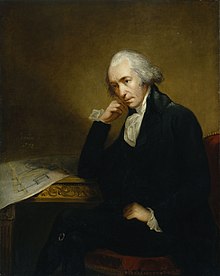
Back James Watt Afrikaans James Watt ALS ጄምስ ዋት Amharic James Watt AN جيمس واط Arabic جيمس وات ARZ জে’মচ্ ৱাট Assamese James Watt AST Ceyms Vatt Azerbaijani جئیمز وات AZB
James Watt | |
|---|---|
 Portrait of Watt (1736–1819) by Carl Frederik von Breda | |
| Born | 19 January 1736 Greenock, Renfrewshire, Scotland |
| Died | 25 August 1819 (aged 83)[a] Handsworth, Birmingham, England |
| Resting place | St. Mary's Church, Handsworth |
| Known for | Watt steam engine Watt's linkage Watt's curve Separate condenser Centrifugal governor Horsepower Indicator diagram Letter copying press Sun and planet gear |
| Spouse(s) | Margaret Miller (m. 1764–1773 her death) Anne McGrigor (m. 1776) |
| Children | 4 |
| Scientific career | |
| Fields | mechanical engineering |
| Institutions | University of Glasgow Boulton and Watt |
| Signature | |
 | |

(Hunterian Museum, Glasgow, by Francis Chantrey)
James Watt FRS, FRSE (/wɒt/; 30 January 1736 (19 January 1736 OS) – 25 August 1819)[a] was a Scottish inventor, mechanical engineer, and chemist who improved on Thomas Newcomen's 1712 Newcomen steam engine with his Watt steam engine in 1776, which was fundamental to the changes brought by the Industrial Revolution in both his native country Great Britain, and the rest of the world.
While working as an instrument maker at the University of Glasgow, Watt became interested in the technology of steam engines. At the time engineers such as John Smeaton were aware of the inefficiencies of Newcomen's engine and aimed to improve it.[1] Watt's insight was to realize that contemporary engine designs wasted a great deal of energy by repeatedly cooling and reheating the cylinder. Watt introduced a design enhancement, the separate condenser, which avoided this waste of energy and radically improved the power, efficiency, and cost-effectiveness of steam engines. Eventually, he adapted his engine to produce rotary motion, greatly broadening its use beyond pumping water.
Watt attempted to commercialise his invention, but experienced great financial difficulties until he entered a partnership with Matthew Boulton in 1775. The new firm of Boulton and Watt was eventually highly successful and Watt became a wealthy man. In his retirement, Watt continued to develop new inventions though none was as significant as his steam engine work.
As Watt developed the concept of horsepower,[2] the SI unit of power, the watt, was named after him.
Cite error: There are <ref group=lower-alpha> tags or {{efn}} templates on this page, but the references will not show without a {{reflist|group=lower-alpha}} template or {{notelist}} template (see the help page).
- ^ Skempton, A. W. "Smeaton, John". Oxford Dictionary of National Biography (online ed.). Oxford University Press. doi:10.1093/ref:odnb/25746. (Subscription or UK public library membership required.)
- ^ Lira, Carl (2001). "Biography of James Watt". egr.msu.edu. Retrieved 5 July 2010.
© MMXXIII Rich X Search. We shall prevail. All rights reserved. Rich X Search